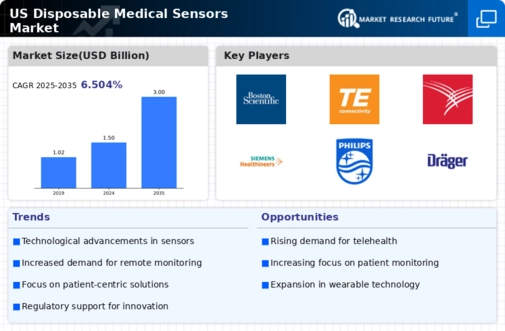The US Disposable Medical Sensors Market is characterized by intense competition and rapid technological advancements, reflecting the growing demand for efficient and reliable healthcare solutions. The increasing prevalence of chronic diseases, the aging population, and the focus on preventive healthcare have spurred innovation and investment in this sector. Manufacturers are continuously striving to enhance the performance and capabilities of disposable sensors, while also prioritizing patient safety and comfort.
As health technology evolves, various stakeholders including medical device companies, healthcare providers, and regulatory bodies interact to shape the landscape, fostering an environment where cutting-edge products can be developed and brought to market swiftly. A wide array of applications ranging from vital signs monitoring to diagnostic procedures are driving the demand for disposable medical sensors, leading to a diverse competitive landscape dominated by a few key players.
Analog Devices has established a strong foothold in the US Disposable Medical Sensors Market by leveraging its expertise in analog technology and signal processing. The company excels at creating high-performance sensing solutions that enhance the accuracy and reliability of medical devices. With a focus on innovation, Analog Devices invests significantly in research and development, ensuring their offerings remain at the forefront of technological advancement.
Their sensors are recognized for superior precision and integration capabilities, which are critical in applications such as patient monitoring systems and diagnostics, thus meeting the stringent demands of healthcare professionals. With a commitment to quality and customer satisfaction, Analog Devices has built a reputation as a trusted supplier in the medical sector, specifically within the US market, reinforcing its competitive edge.
Medtronic is another key player in the US Disposable Medical Sensors Market, well-known for its diverse portfolio of medical technologies and services aimed at improving patient care. The company's product offerings include a range of disposable sensors used in various applications such as continuous glucose monitoring and cardiac rhythm management. Medtronic's strengths lie in its extensive research and development capabilities, allowing it to introduce innovative solutions that cater to evolving healthcare needs.
The company has a substantial presence in the US market, backed by significant investments in strategic mergers and acquisitions that have expanded its product range and technological capabilities. By continuously enhancing its sensor technologies and maintaining strong relationships with healthcare providers, Medtronic demonstrates a commitment to lead in disposable medical sensors while addressing the complex challenges faced in modern medicine.




















